“I am not a goat.”
That is what I kept tearfully telling Ben while we were standing on the side of a mountain last week.
He reassuringly told me I was doing a good job and that if I fell down the mountain, I certainly wouldn’t die.
I quickly interrupted him to inform him that his talk of falling off the mountain wasn’t helping me feel better about falling off the mountain.
But, let me back up.
Late last week we finished our loop around the Northland of New Zealand’s North Island. We wanted to do several hikes during our time in New Zealand, but since Wi-Fi has been hard to come by, we hadn’t been able to do as much research on the weather or gear for the treks as we would’ve liked. On Saturday, we made it south of Auckland and stopped in a cafe in Matamata (home of Hobbiton) which happened to have Wi-Fi. Since we had about a week to get to Wellington, we figured we’d check the weather and decide what days looked best to do some of the hikes on the south part of the North Island.
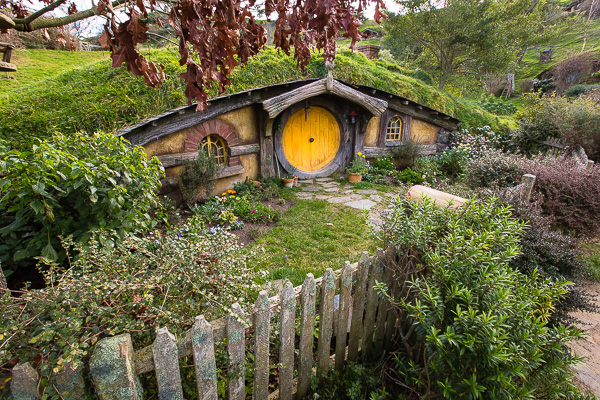
We were limited to one day with sun in the forecast while the rest of the week was full of rain. After doing a bit more research on the hikes we wanted to do, we realized our hiking experience didn’t include avalanche training or the appropriate gear to do these hikes on our own during the winter season. Since the weather limited our time-frame, we decided to focus on the top of our list – the Tongariro Alpine Crossing. It is referred to by many as the prettiest one-day hike in the world, is part of one of the nine Great Walks in New Zealand, and is also a World Heritage Site.
Now, all we had to do was call the guide company we’d researched and determine if they had any spots available for the tramp the next day. We were in luck, and they told us to be in downtown Taupo the next morning at 6 a.m. to get picked up for the start of our hike.
We spent the afternoon at Hobbiton before driving the 120 Km, about 90 minutes, to Taupo. By 6 a.m. the next morning we were in a van with nearly a dozen other hikers headed towards the gear location for our trekking company. When we arrived, our guides made sure everyone had at least two warm layers on our legs, at least three warm layers on our torso, appropriate hiking boots, hats, gloves, sunglasses, gaiters, helmets, ice axes, and crampons.
For those new to hiking in winter like us, gaiters are sort of like water-resistant leg warmers which go over your pants and shoes from your knees down. Their purpose is to keep snow, mud, water, etc. from getting into your boots and/or up your pant legs. Crampons are essentially metal spikes that you fasten onto your boots. They have two big teeth that stick out the front of your shoe, and another six or eight on the bottom to give you traction in the snow and ice.
Once everyone was fully outfitted we got on a bus and drove to the start of the Tongariro Alpine Crossing.
The Start of the Tongariro Alpine Crossing
When we arrived, the guides were shocked by how beautiful and warm the weather was. They encouraged us to take off a few layers so we wouldn’t sweat through our base layers and be miserable later on. We also took advantage of the bathroom facilities since they were few and far between on our 21-kilometer trek. Then it was time to hike.
Our guide Justin told us to enjoy the first 4 km since they would be “flat” and were the easiest of our 21 km that day. After climbing several large hills, we were questioning his idea of “flat” but continued onward enjoying the beautiful views of the snowcapped mountains surrounding us.
The Tongariro Alpine Crossing is a path that traverses a volcanic mountain range including Mt. Tongariro and Mt. Ngauruhoe. For those Lord of the Ring fans, Mt. Ngauruhoe, is Mount Doom.
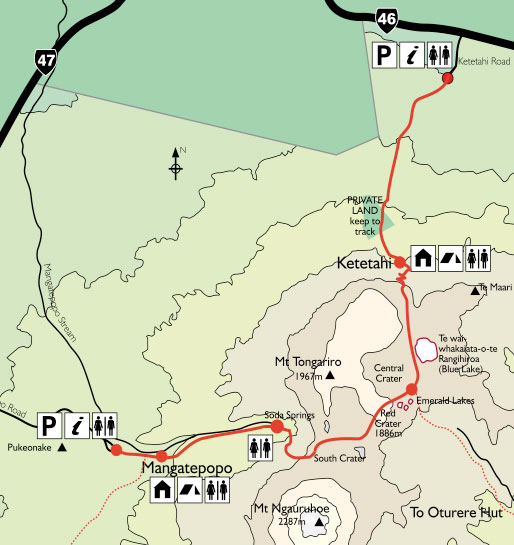
Before long, we were told to brace ourselves as the first of two big climbs were about to take place. Justin said that while the first 4 km was the easiest, the next four would be the most challenging. It was time for the Devil’s Staircase. Before starting the climb, we received an “Ice Axe 101” lesson from Andrea, another of our guides. She taught us how to hold the ice
While the guides all said the Devil’s Staircase was the most challenging climb, Ben and I actually disagreed. It was far from easy, but in comparison to the next climb, it was a piece of cake. When we got to the top of the Devil’s Staircase we were given a breather and an opportunity to take a few pictures. Then, we were shown how to put on our crampons and taught how to use them.
I will be honest, I wasn’t too scared at this point. Instead, I was just feeling fatigued after a big climb and because I am not in the best shape.
Then, it was time for the second big climb to the Red Crater where we went from 1,600 to 1,900 m. The crampons were necessary because we were climbing up such a steep grade that you had to walk as if you were a ballet dancer in the first position, or a duck, with your ice
For me, this was about the time I realized while I am not afraid of heights, I am very afraid of falling off things, for example, mountains. I learned quickly to just stare at my feet and the snow around them to make sure I had a good step and to ignore how far it was down to the bottom. With Ben’s words of encouragement and his heavy breathing matching mine, we made it to the top. We had now been hiking for about four hours. When we got to the top, it was time for lunch with a bit of a view. We had just enough time to eat our sandwich and then continued on.
I was pretty shaky at this point. My legs were starting to cramp up and I knew we still had the majority of the hike left. Justin did keep reminding us that even though we had only hiked 8 km so far, it was basically equivalent to doing half the route because there was so much more effort exerted in the first 8 km due to the two big climbs. So, after we finished our sandwiches, we stood up to continue on our way. I didn’t realize our CamelBack had disconnected from the drinking tube though, so it dumped a large portion of our water down my back and pants. Not exactly what you want when you are hiking for at least four more hours in the ice and snow.
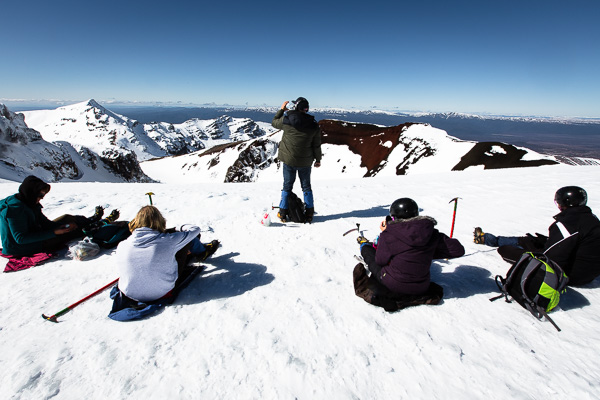
Glissading Goodness: My Favorite Part of the Tongariro Alpine Crossing
Thank goodness the next part of the tramp was my favorite or I might have been too discouraged to continue. We were told to take off our crampons and get ready to glissade, which is sledding minus the sled, down the mountainside. We put our backpacks on our front, put our ice axe by our side as if it was a canoe paddle, and pushed off. After hours of hiking uphill, it was fun to slide down and relax a bit. We stood up long enough to walk a few steps to the next path down and slid again. After several glissades, we reached the crater by the frozen Emerald Lakes and were able to walk on flat ground for about 20 minutes. It felt good to be out of the crampons and walking on something which felt so much more secure than the side of a mountain. Little did I know we would soon be coming to the most challenging part of the climb for me.
The guides we had during our trip were fantastic. There were about 25 hikers and we had four guides who were all very knowledgeable about the tramp we were on and were extremely passionate about New Zealand and the outdoors. They hike the Tongariro Alpine Crossing three to five times each week all year long and therefore know it extraordinarily well.
Our guides had hiked the trail the day before and noticed the upcoming portion of the tramp was damaging some of the plant life on the trail. The DOC in New Zealand makes it clear that it is okay to go off the trail in the winter season, as long as there is no lasting trace when the snow melts. The guides knew there wasn’t enough snow to walk their typical path without impacting the area, so they decided to take us a different route. One I’ve dubbed “The Goat Path.”
Hiking the Goat Path
The typical trail route would’ve brought us down in elevation onto, what I’ve been told, is a bit flatter ground in the valley between the mountains. The Goat Path required us to wind around the mountain, keeping a flat elevation at about two-thirds of the way to the top, on a path of melting slushy snow no more than eight inches wide.
I am not a goat. I consider myself pretty sure-footed, but that all goes out the window when you are on the side of a mountain walking one foot in front of the other, heel to toe as if you were on a balance beam 1,000 meters in the air.
We were told to always put our ice axe on the uphill side of our bodies, and for this 90-minute span, that was our left side. The snow had started to melt into a slushy substance. It would’ve been perfect snow-man making snow. It wasn’t perfect snow to walk on though, as sometimes when you stepped down, you’d sink in and slide several inches down the side of the mountain.
I typically love being up high and looking at things. However, I am terrified of falling off edges, and with a small ledge of melting snow and my left arm the only thing to catch me, I was nearly paralyzed with fear.
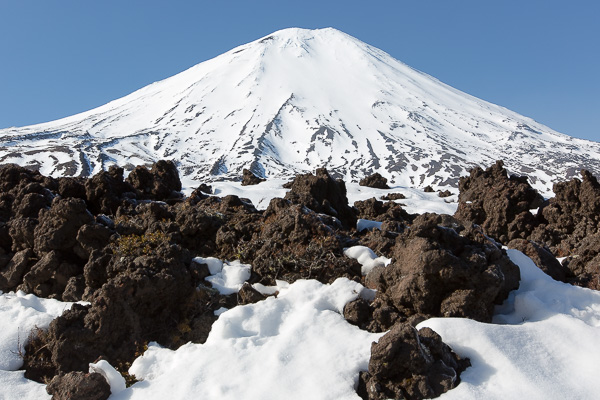
Did I mention that I was also leading the way for half of our hiking group? Yep, I had more than a dozen people directly behind me wondering why I was walking so slowly. Oh, and then my right calf which was on the verge of cramping up the entire trek decided this would be the time to cramp.
I was thankful Ben was behind me to grab me by my backpack and help me up so I could stretch my calf and keep on trekking. However, adding to my anxiety of this small footpath, was the fear my calf would cramp up again and cause me to fall down the side of this mountain.
Ben’s pep talks about how I really couldn’t fall to the bottom of the mountain were no help as I breathed in one shaky breath after another.
My own internal monologue was interrupted when one of the hikers behind me lost her jumper (sweater) from her pack and we all watched it roll down, down, down, the side of the mountain. Our guide jumped off the path to try and chase it by glissading but couldn’t catch it before it went over a big rocky
I think it was the longest 90 minutes of my life. I am confident that if I didn’t have the pressure of a dozen people right on my heels, I probably would’ve been unable to move forward at certain points. Even writing this my heart is racing.
But, I made it.
A Slow and Ugly Finish
From The Goat Path, we got back onto a wider track which led us to our last stopping point on the trail. We sat down for 10 minutes and ate a snack and I tried to stop shaking. From that last stop, there was only 90 minutes, 6.4 km, of the Tongariro Alpine Crossing left.
My body hurt at this point. I think the anxiety of The Goat Path had caused me to tense all my muscles and I was beyond sore. Although my calves weren’t cramping any longer, the lingering pain of the cramps made it hard to walk. I had made it through the hardest part of the tramp but I was mentally starting to give up.
The last 6 km weren’t physically hard. They were mostly downhill but I was wiped. Ben was trying to pep me up, but I wasn’t having it. I hurt, I was tired, and I didn’t want to go on. I didn’t think there was anything left in my tank. But then, two of our guides caught up with us. They had been further back on the trail helping another hiker who had a panic attack on The Goat Path – that path was the worst. For the next 4 km, they chatted with us about different topics, enough to get my mind off my hurting legs and negative thoughts. We got to see a silver fern and learn more about the plant that is so important to the people of New Zealand and even got to taste a pepper plant.
As we cruised or limped, across the end of the trail we were cheered on by our guide Justin and quickly given a beer to celebrate our accomplishment.
I am sure one day, hopefully, in the near future, I will be more proud of completing the Tongariro Alpine Crossing. For now, I am still in the, “that was scary, I don’t want to do it again,” mindset. All I know for sure, is I am not a goat. No matter what Ben tries to convince me of.
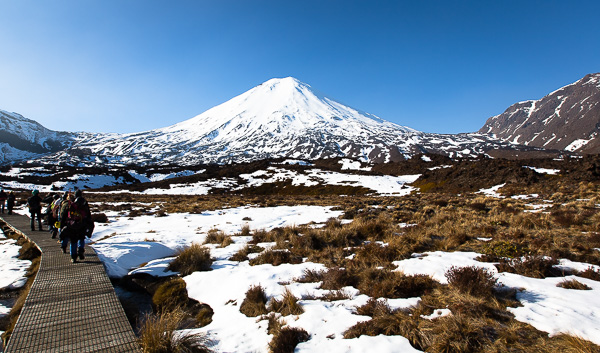
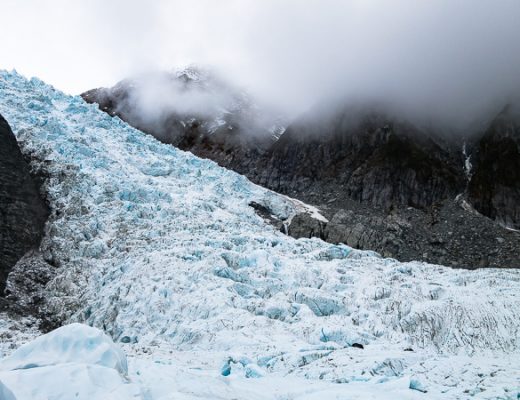
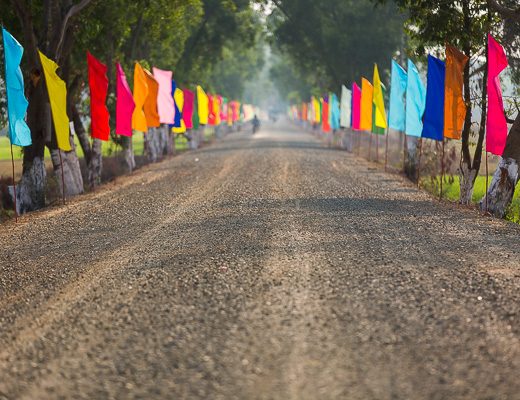

Goose
August 25, 2016 at 1:04 pmSarah, thank you for taking us with you on your adventure. It was as if I was there but had the advantage as I didn’t have the fear of falling off a mountain, as you did. Looking forward to future posts!
thelawsoftravel@gmail.com
August 26, 2016 at 1:30 amHaha – you got the better end of the deal I think! Although, I think I am nearly to the point where I can talk about it without shaking. 😛
Chappy
August 29, 2016 at 12:40 pmHope you enjoyed all of the tramping 🙂 we cannot wait to take your trip tips when we go to New Zealand sometime in our lives! Looks like you guys are having a blast!
thelawsoftravel@gmail.com
August 29, 2016 at 8:09 pmWe are taking a day off today to plan our next few tramps, can’t wait to share with you guys!
Five Stages of Hiking From a Wannabe Hiker – The Laws of Travel
September 17, 2016 at 9:14 am[…] have definitely been challenging parts of all of the hikes we have done (goat path anyone?) but when we talked with a large group of experienced hikers at the end, they were also saying this […]
Franz Josef Glacier Heli-Hike - The Laws of Travel
September 21, 2016 at 8:40 pm[…] could choose from and we selected the one that would fit us best. I will be honest that after our goat path fiasco, I was a bit nervous to walk on snow and ice again so soon. Figuring that in, we choose a tour with […]